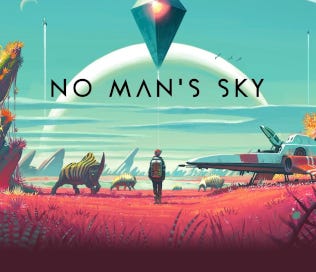The lure of "endless wilds" to explore
And how Outer Wilds and No Man's Sky taught me something about what I actually desire in a virtual space.
Vague spoilers for the Outer Wilds - go play that game first, it might change your life
Procedural generation was a special interest of mine in my twenties. I would read articles about it on Gamasutra while a housemate and I experimented with various island generation techniques, and I wondered at the thought of the generated galaxies of Elite, and of Will Wright hiring all those demoscene programmers for the upcoming Spore (2008) game and what incredible scales they were dealing in.
Minecraft (2011) felt like a vindication of this idea - you could, if you like, just keep wandering in a single direction for a very, very long time, all the while encountering unique new landscapes. I guess I didn’t think too deeply about what was actually fun to do in Minecraft, which was messing around with my friends, building absurd bases and getting surprised by creepers blowing our shit up.
I heard about No Man’s Sky (2016) firstly when the bad reviews first hit. It turned out that they’d sold people too successfully on the fantasy of an endless space wild west, where one could pitch out into the darkness to discover whole new galaxies. The expectations were at 120, the reality was at.. maybe 80. It turned out that endless amounts of basically the same thing was not very compelling to people.
I didn’t get NMS at the time. But I kept hearing about it as it slowly transformed into quite a feature-rich space (something that I believe is still going on). In the meantime, I met a game in quite a different vein: Outer Wilds.

Outer Wilds is far from endless - it is a toy solar system consisting of one sun, about six planets/planetoids, three moons, various other interesting bits and pieces, and one comet. It’s possible to see a lot of it in, say, a 22-minute window, should one be compelled to for some reason.
In fact, and I love this about the game, there is nothing stopping you from completing the game in the first forty or so minutes - nothing, that is, except your ignorance. You could speed run this thing in no time [Editor: the author went and looked up the current speedrun records and the Any% is an incredible 7m57s, though the 100% is a hair over 40m]
What it lacks for in scope it makes up for in density. Every part of every world, every satellite, every scrap of ancient writing, is worth seeing and experiencing. Singular physics wonders like the Hourglass Twins, with sand running from one to the other, covering some building’s features while exposing others, are astonishing to witness. Brittle Hollow’s core is a black hole and it is rapidly collapsing, whole chunks getting pulled into the event horizon even as you race through it to discover its secrets. Riding a rickety rocket through the perpetual planet-wide storm of Giant’s Deep is exhilarating, and sneaking quietly through Dark Bramble is… well. If you’ve tried it you know.

It’s an incredible game. It changed my friend’s attitude to death and dying, and it probably changed mine a little, too. There’s nothing quite like joining a campfire, listening to your fellow astronauts all around the solar system play a shared song via the radio, and meditating as [REDACTED].
Then I picked up NMS on sale and put a few hours into it. And I discovered that what I thought that I wanted - an endless expanse to explore - was not what I actually want, at all. It’s fine, a big space is.. fine, but the defining trait of a sandbox is that it has boundaries.
I don’t want a large expanse of dead sand; I want a coral reef, teeming with life, rich in meaning and layers and accidental discoveries.
And so I’m grateful to both No Man’s Sky and Outer Wilds for disabusing me of a thing that I thought that I desired.




